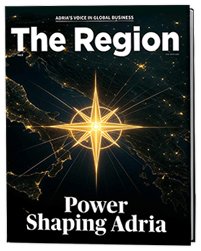In a luminous hall in Belgrade earlier this autumn, more than four hundred women from across the Adriatic–Danube region gathered to talk about power — not the kind that dominates, but the kind that endures. The air was charged with the quiet conviction that something fundamental was shifting. For the first time in years, the question wasn’t whether women could lead, but how their leadership would redefine what influence means in this part of Europe.
Across the Adria, from Ljubljana to Tirana, a generation of women is quietly changing the grammar of authority. They are less interested in titles than in traction, less in hierarchy than in impact. Their ascent is measured not by how loudly they claim space, but by how deliberately they build it. Yet behind this progress lingers a familiar resistance — the slow grind of entrenched norms and the invisible ceiling of networks still dominated by men.
THE QUIET REVOLT
The corridors of power in the region have long been designed for someone else’s stride. For decades, women were ushered toward what organisations called the “soft” portfolios — human resources, communications, education — while the hard levers of finance, energy, and infrastructure remained out of reach. That pattern is changing. Slowly, but unmistakably.
New initiatives have begun knitting together business networks, NGOs, and policymakers across borders to widen the pipeline of women entering executive and board roles.
The movement is not about quotas or optics; it’s about competence being seen, and potential being trusted. In recent leadership gatherings, the conversation has shifted from survival to redesign. One participant captured the sentiment that threaded through the room: “Maybe the real task isn’t for women to adapt to power, but for power to evolve with women.”
POWER, REIMAGINED
The most striking transformation isn’t numerical — it’s philosophical. The women rising in the Adria aren’t seeking to mimic old models of command.
They are reshaping the architecture itself. In systems where patronage and hierarchy often stifle change, they build horizontally: coalitions of entrepreneurs, civic leaders, technologists, and public officials who share a goal rather than a chain of command.
They measure success differently too. Influence outweighs authority. Cooperation outperforms control. Their leadership style is pragmatic yet relational — born of necessity in societies where progress still depends on personal networks, but honed through the digital fluency and global exposure of a younger generation.

That does not make the climb easier. Many describe carrying what one executive called “the extra-mile tax” — the constant, unspoken need to prove legitimacy in rooms where expectation still defaults to male. Yet it is that tension that seems to sharpen their edge. What once exhausted them now fuels them. Rejection becomes reinvention. Barriers turn into laboratories for strategy.
MOMENTUM AND FRICTION
Change rarely moves in straight lines. In sectors like transport and logistics, where male dominance once felt unshakable, governments and regional institutions are now actively encouraging women to step forward. In Gorizia last year, more than sixty women entrepreneurs from eight Adriatic–Ionian countries gathered to forge connections and chart a new map of cross-border collaboration — a small but symbolic act of collective ambition.
The European Union’s directive on gender balance in corporate boards, set to become fully enforceable in 2026, is also rippling through the region. Even in countries where it has no formal power, it has become a mirror: a benchmark that exposes how far there is still to go.
But progress sits beside backlash. In many political and business circles, the old scripts persist — that women should lead quietly, or graciously, or not at all. In patriarchal cultures where influence often flows through informal networks of loyalty and lineage, the outsider’s path remains uphill. And in a moment of global polarisation, gender equality itself has become a political fault line, framed by some as ideology rather than modernity.
WHY IT MATTERS
The question of female leadership in the Adria is not a moral debate; it is an economic one. Regions that waste half their talent inevitably fall behind. As Europe faces demographic contraction, digital transition, and the climate crisis, inclusive leadership has become less a virtue than a survival strategy.
Evidence already points in one direction. Companies with women in senior roles report stronger governance and steadier long-term growth. Public institutions led by women often earn higher trust from citizens. And in policymaking, where decisions on care, labour, and energy intersect, women tend to widen the frame — not out of sentiment, but because they see connections that rigid systems overlook.
The region’s future competitiveness will depend on whether those insights become structural. It will require transparency in appointments, earlier investment in mentorship and education, and men who see equality not as concession but as collective advantage.
The recalibration will take time — but the clock is already ticking.
THE BALANCE TAKING SHAPE
Something irreversible is happening. The Adria’s age of token inclusion is fading, replaced by a quieter, more confident balance of power. These women are not demanding seats at old tables; they are designing new ones. Their approach is less about confrontation than about continuity — expanding what leadership means, and who it serves.
They lead from boardrooms and ministries, from startups and research labs, from classrooms and climate coalitions. Their stories do not shout, but they endure. Taken together, they trace the outline of a region discovering that equality is not the opposite of power — it is the evolution of it.
A new balance is not coming. It is already here, reshaping the Adriatic arc one decision, one alliance, and one quiet act of leadership at a time.

